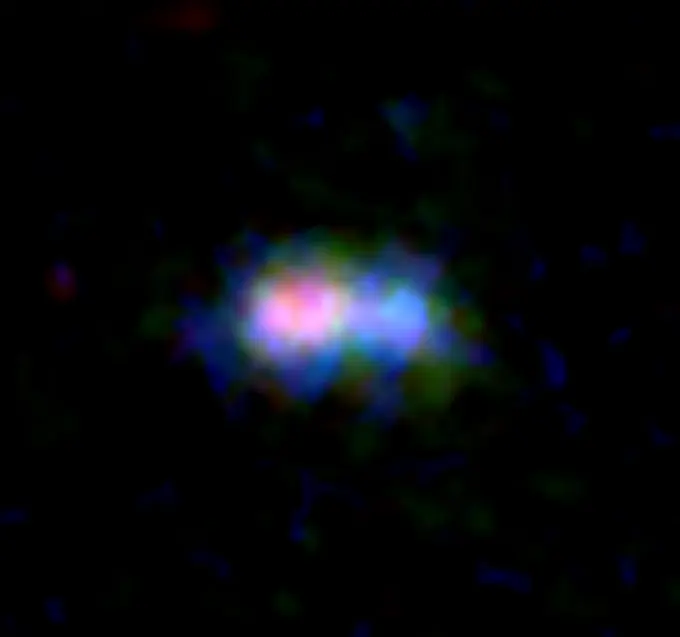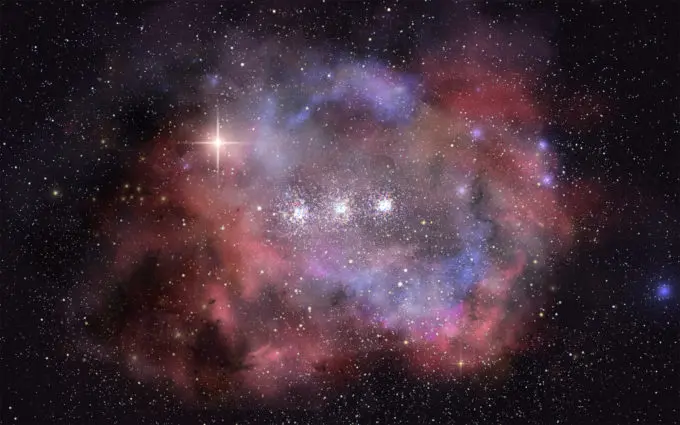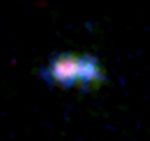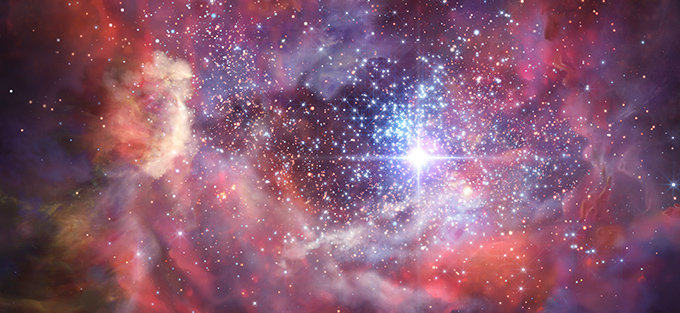The Rise and Fall of Ziggy Star Formation and the Rich Dust from Ancient Stars
Researchers have detected a radio signal from abundant interstellar dust in MACS0416_Y1, a galaxy 13.2 billion light-years away in the constellation Eridanus. Standard models can't explain this much dust in a galaxy this young, forcing us to rethink the history of star formation. Researchers now think MACS0416_Y1 experienced staggered star formation with two intense starburst periods 300 million and 600 million years after the Big Bang with a quiet phase in between.
Stars are the main players in the Universe, but they are supported by the unseen backstage stagehands: stardust and gas. Cosmic clouds of dust and gas are the sites of star formation and masterful storytellers of the cosmic history.
“Dust and relatively heavy elements such as oxygen are disseminated by the deaths of stars,” said Yoichi Tamura, an associate professor at Nagoya University and the lead author of the research paper, “Therefore, a detection of dust at some point in time indicates that a number of stars have already formed and died well before that point.”
Using ALMA (Atacama Large Millimeter/submillimeter Array), Tamura and his team observed the distant galaxy MACS0416_Y1. Because of the finite speed of light, the radio waves we observe from this galaxy today had to travel for 13.2 billion years to reach us. In other words, they provide an image of what the galaxy looked like 13.2 billion years ago, which is only 600 million years after the Big Bang.
The astronomers detected a weak but telltale signal of radio emissions from dust particles in MACS0416_Y1 [1]. The Hubble Space Telescope, the Spitzer Space Telescope, and the European Southern Observatory’s Very Large Telescope have observed the light from stars in the galaxy; and from its color they estimate the stellar age to be 4 million years.
“It ain’t easy,” said Tamura half-lost in a moonage daydream. “The dust is too abundant to have been formed in 4 million years. It is surprising, but we need to hang onto ourselves. Older stars might be hiding in the galaxy, or they may have died out and disappeared already.”
“There have been several ideas proposed to overcome this dust budget crisis,” said Ken Mawatari, a researcher at the University of Tokyo. “However, no one is conclusive. We made a new model which doesn't need any extreme assumptions diverging far from our knowledge of the life of stars in today’s Universe. The model well explains both the color of the galaxy and the amount of dust.” In this model, the first burst of star formation started at 300 million years and lasted 100 million years. After that, the star formation activity went quiet for a and then restarted at 600 million years. The researchers think ALMA observed this galaxy at the beginning of its second generation of star formation.
“Dust is a crucial material for planets like Earth,” explains Tamura. “Our result is an important step forward for understanding the early history of the Universe and the origin of dust.”
Notes
[1] ALMA marginally detected dust emissions in a galaxy A2744_YD1 with a similar age MACS0416_Y1. The detection of dust in the present research has a better signal-to-noise ratio.
Additional Information
These observation results were published as Tamura et al. “Detection of the Far-infrared [O III] and Dust Emission in a Galaxy at Redshift 8.312: Early Metal Enrichment in the Heart of the Reionization Era” in the Astrophysical Journal in March 2019.
The research team members are:
Yoichi Tamura (Nagoya University), Ken Mawatari (Osaka Sangyo University/The University of Tokyo), Takuya Hashimoto (Osaka Sangyo University/National Astronomical Observatory of Japan), Akio K. Inoue (Osaka Sangyo University), Erik Zackrisson (Uppsala University), Lise Christensen (University of Copenhagen), Christian Binggeli (University of Copenhagen), Yuichi Matsuda (National Astronomical Observatory of Japan/SOKENDAI), Hiroshi Matsuo (National Astronomical Observatory of Japan/SOKENDAI),Tsutomu T. Takeuchi (Nagoya University), Ryosuke S. Asano (Nagoya University), Kaho Sunaga (Nagoya University), Ikkoh Shimizu (Osaka University), Takashi Okamoto (Hokkaido University), Naoki Yoshida (The University of Tokyo), Minju Lee (Nagoya University/National Astronomical Observatory of Japan), Takatoshi Shibuya (Kitami Institute of Technology), Yoshiaki Taniguchi (The Open University of Japan), Hideki Umehata (The Open University of Japan/RIKEN/The University of Tokyo), Bunyo Hatsukade (The University of Tokyo), Kotaro Kohno (The University of Tokyo), and Kazuaki Ota (University of Cambridge/Kyoto University).
This research was supported by JSPS/MEXT KAKENHI (Nos. 17H06130, 17H04831, 17KK0098, 17H01110, 18H04333, and 17K14252) and the Swedish National Space Board.
The Atacama Large Millimeter/submillimeter Array (ALMA), an international astronomy facility, is a partnership of the European Organisation for Astronomical Research in the Southern Hemisphere (ESO), the U.S. National Science Foundation (NSF) and the National Institutes of Natural Sciences (NINS) of Japan in cooperation with the Republic of Chile. ALMA is funded by ESO on behalf of its Member States, by NSF in cooperation with the National Research Council of Canada (NRC) and the Ministry of Science and Technology (MOST) and by NINS in cooperation with the Academia Sinica (AS) in Taiwan and the Korea Astronomy and Space Science Institute (KASI).
ALMA construction and operations are led by ESO on behalf of its Member States; by the National Radio Astronomy Observatory (NRAO), managed by Associated Universities, Inc. (AUI), on behalf of North America; and by the National Astronomical Observatory of Japan (NAOJ) on behalf of East Asia. The Joint ALMA Observatory (JAO) provides the unified leadership and management of the construction, commissioning and operation of ALMA.
Images

ALMA and Hubble Space Telescope (HST) image of the distant galaxy MACS0416_Y1. Distribution of dust and oxygen gas traced by ALMA are shown in red and green, respectively, while the distribution of stars captured by HST is shown in blue. Credit: ALMA (ESO/NAOJ/NRAO), NASA/ESA Hubble Space Telescope, Tamura, et al.

Artist’s impression of the distant galaxy MACS0416_Y1. Based on the observations with ALMA and HST, researchers assume that this galaxy contains stellar clusters with a mix of old and young stars. The clouds of gas and dust are illuminated by starlight. Credit: National Astronomical Observatory of Japan
Contacts
-
Nicolás Lira
Education and Public Outreach CoordinatorJoint ALMA Observatory, Santiago - ChilePhone: +56 2 2467 6519Cel: +56 9 9445 7726Email: [email protected] -
Masaaki Hiramatsu
Education and Public Outreach Officer, NAOJ Chile -
Charles E. Blue
Public Information OfficerNational Radio Astronomy Observatory Charlottesville, Virginia - USAPhone: +1 434 296 0314Cel: +1 202 236 6324Email: [email protected] -
Calum Turner
ESO Assistant Public Information Officer




